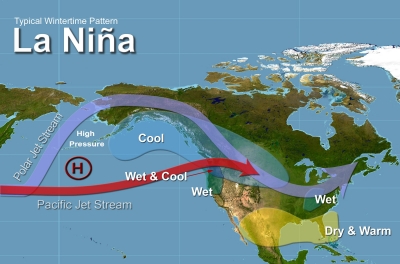
|
Meaning “the little girl” in Spanish, La Niña is a climatic pattern caused by a build-up of cooler-than-normal waters in the tropical Pacific, the area of the Pacific Ocean between the Tropic of Cancer and the Tropic of Capricorn. The drastic drop in sea-surface temperature affects patterns of rainfall, atmospheric pressure and atmospheric circulation around the world. |
La Niña is a climate pattern that describes the cooling of surface ocean waters along the tropical west coast of South America. La Nina is considered to be the counterpart to El Nino, which is characterized by unusually warm ocean temperatures in the equatorial region of the Pacific Ocean.
Together, La Niña and El Niño are the “cold” (La Niña) and “warm” (El Niño) phases of the El Nino-Southern Oscillation (ENSO). ENSO is series of linked weather- and ocean-related phenomena. Besides unusually warm or cool sea-surface temperatures, ENSO is also characterized by changes in atmospheric pressure.
La Niña events sometimes follow El Niño events, which occur at irregular intervals of about two to seven years. The local effects on weather caused by La Niña (“little girl” in Spanish) are generally the opposite of those associated with El Niño (“little boy” in Spanish). For this reason, La Niña is also called anti-El Niño and El Viejo (the old man in Spanish).
Scientists use the Oceanic Nino Index to measure the deviations from normal sea-surface temperatures that El Niño and La Niña produce in the east-central Pacific Ocean. La Niña events are indicated by sea-surface temperature decreases of more than .5 degrees Celsius (.9 degrees Fahrenheit) for at least five successive three-month seasons.
La Niña is caused by a build-up of cooler-than-normal waters in the tropical Pacific, the area of the Pacific Ocean between the Tropic of Cancer and the Tropic of Capricorn. Unusually strong, eastward-moving trade winds and ocean currents bring this cold water to the surface, a process known as upwelling.
Credit: National Geographic Society
Picture credit: NOAA




